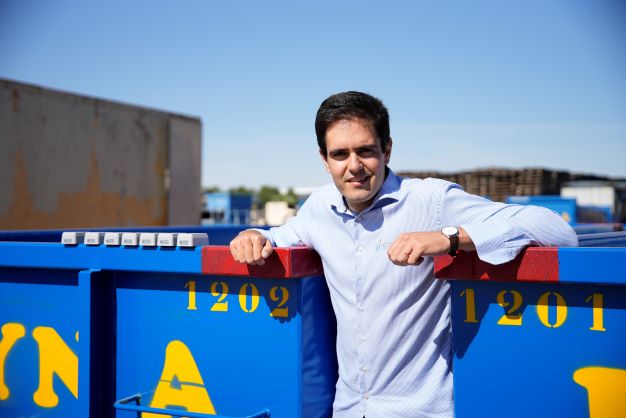Marcos Arizti knows what it’s like to back his own experience when a major project faces huge challenges.
Soon after Marcos took on the role of CEO of Norwegian start-up StalkIT, spearheading the company’s development of a tracking device for commercial waste management, the COVID-19 pandemic all but halted the rollout of the supporting Narrowband IoT (NB-IoT) connectivity infrastructure. But rather than abandon the project, Marcos and his team pushed on, believing the StalkIT track and trace technology had the potential to revolutionise the waste industry.
It’s a decision that has paid off. The rollout has now caught up and just two years later, StalkIT is one of the biggest NB-IoT asset start-ups in Europe, with more than 35,000 units online in nine countries and three verticals – waste, livestock and equipment.
“Our biggest challenge was that we created a product that was very expensive to design and produce, but it was too early in the market,” explains Marcos. “We were going to meetings with the telcos and they were saying ‘This is the first device we’ve seen that uses our technology’. It also limited where we could operate.”
How early was it? Marcos’s team created the tracker from a prototype in just six months – a feat he claims as one of his proudest career achievements. It also reflects Marcos’s personal motto: ‘Never leave to tomorrow what you can do today’. “It was quite an accomplishment considering all the approvals, people involved and things that could have gone wrong. We had a device with no hardware or software problems, which was fantastic,” he says.

Waste management opportunities
Marcos, who is originally from Bilbao in Northern Spain, never really planned on being in waste management. He says he was drawn into it.
“My original passion growing up was the automotive industry, so cars and bikes,” says Marcos. “But a brief stint as an exchange student in Finland while studying my Master of Science in Mechanical Engineering ignited my interest in the potential of energy in waste.
“At the time, they weren’t talking much about waste as just garbage, but as a resource – same as we have coal or gas or any other kind of resource. It was something from which you can extract energy, heat and electricity.”
The potential in waste appealed to his technical mind, a trait that seems to run in his family. Marcos’s father, whom he lists as one of his greatest inspirations, is an accomplished architect who has also lived and worked outside of Spain. He also has two brothers, one who is an architect and the other an engineer. His mother is a psychologist – “she was often the referee between us siblings while we were growing up,” he says.
Marcos was at one stage contemplating becoming an architect himself, but looks back on more than 13 years spent in waste management in the Nordic countries – including 4 years as business development manager of BMH Technology Oy Finland, a turn-key waste treatment plants provider.
Marcos says digitisation of waste management has enormous transformative potential. He sees changing this paradigm as one of his personal missions. “When I started, there was IoT for infrastructure businesses but not for waste management,” he says. “Even today, if you ask managers in waste management companies where their containers are, and how many they have, many cannot tell you.”
Why waste management digitisation has a big future
Marcos says a serious challenge is convincing asset managers of the value proposition of digitisation. “Here we are creating something completely new,” he says. “People will say ‘I’ve never tracked containers, I’ve never had any control over individual assets, so why should I do it?’ There’s two parts to that: the first is to make your business more efficient, because the ones who aren’t taking the step here are going to be left behind – just like taxis were with Uber.”

Marcos explains users who adopt digital technology have more data about who collected the waste and where it came from. They can also increase their revenue because they’ll have information such as where their containers are and how long they spend in particular spots. “We believe that whatever we measure can be first improved and later on predicted,” he says. “We have developed a tailor-made tool which will help waste operators have a data-driven business.”
The second reason Marcos says waste management businesses should adopt digital tracking is it will make the industry itself more transparent. “In the future you need to have traceability over what’s happening on each individual container, you need to be able to designate specific trucks to specific routes, minimise the CO2 footprint,” he says. “All these things are what the authorities and regulators are interested in.”
One of the best ways to spread this message is through engagement with organisations, says Marcos. He speaks fondly of organisations such as IPWEA that provide information about industry-transforming technologies and trends. As a keynote speaker at the upcoming International Public Works Conference 2021, he looks forward to talking about “how field tools like digital trackers are going to make waste management business more efficient”.
“Waste management is not a very glamorous business on its own, but it does have a lot of potential,” says Marcos. “We produce waste every day. So, it’s something that we need to continually find solutions for, and digitisation is part of this process.”
As a glimpse into his personal life, Marcos is still into cars, but says with a family and two children he has less time to indulge in “these toys”. A day off now will find him enjoying the bountiful natural environments of Norway, either hiking with family and friends or skiing. He also enjoys food and wine, and has mastered cooking the perfect Spanish omelette. Another handy skill in an impressive repertoire.














